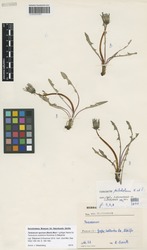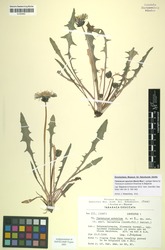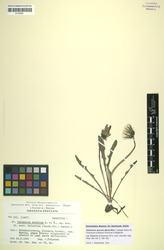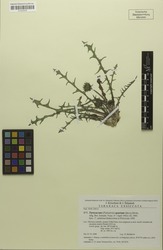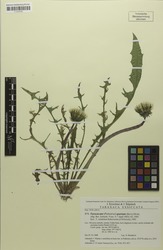Wissenschaftlicher Name
Taraxacum spurium (Beck) Murr
Synonyme
Taraxacum subdolum Kirschner & Štěpánek
Deutscher Name
Hinterhältiger Löwenzahn
Anmerkung zur Verbreitung
vorwiegend im östl. Mitteleuropa; in Mecklenburg-Vorpommern (Pasewalk: Großer Koblentzer See) verschollen, das erloschene Vorkommen in Mecklenburg-Vorpommern galt lange Zeit als einziger Nachweis der Art für Deutschland, erst 2009 Neufund für Bayern (Staffelseegebiet, vgl. Lippert & Meierott 2014)
Standort
feuchte mineralstoffreiche oder salzbeeinflusste Wiesen, überflutete Wiesen, Kalksümpfe

Wuchshöhe (cm)
8–22
Blattstiel
purpurn, ungeflügelt
Blattrand
deutlich gelappt
Blattendlappen
spitz zulaufend, schmal dreieckig bis spießförmig
Blattseitenlappen
beiderseits 2–5, schmal bis oft breit dreieckig, ± gegenständig, abstehend bis zurückgebogen, ± ganzrandig oder Oberkante mit einzelnem Zahn
Blattbuchten
ganzrandig
Schaft
blass grünlich braun, oft purpurn überlaufen, schwach spinnwebig behaart
Hülle
8–11 mm breit, U-förmig
Äußere Hüllblätter
(13–) 15–21, locker anliegend bis aufrecht-abstehend, nicht dachziegelig, eiförmig bis eilanzettlich, 8,5–10 mm lang, (3–) 4–5,5 mm breit, nicht bewimpert, schwarzgrün, meist glänzend; mit ausgedehntem, von Randfeld nicht trennbaren dunklen Mittelstreifen; Hautrand deutlich abgesetzt, 0,1–0,5 mm
Blüten
Blütenköpfe sattgelb, Ø 3,0–4,0 cm; innere Blütenzähne schwärzlich
Pollen
vorhanden
Frucht
4,2–4,4 mm lang, oben spärlich mit kleinen, kurzen Stacheln besetzt; Pyramide fast zylindrisch, 1–1,4 mm lang; Rostrum 8–9 mm lang
Griffel
Griffeläste grünlich mit dunklen Borsten
Weitere Merkmale
Chromosomenzahl
2n = 3x = 24
Ähnliche Arten
T. vindobonense
Lectotypus (JSTOR Global Plants)
Syntypus? (JSTOR Global Plants)
Isotypus zu Taraxacum subdolum (JSTOR Global Plants)
Isotypus zu Taraxacum subdolum
Isotypus zu Taraxacum subdolum (JSTOR Global Plants)
Isotypus zu Taraxacum subdolum
Isotypus zu Taraxacum subdolum
Isotypus zu Taraxacum subdolum (JSTOR Global Plants)
Isotypus zu Taraxacum subdolum (JSTOR Global Plants)
Isotypus zu Taraxacum subdolum (JSTOR Global Plants)
Paratypus zu Taraxacum subdolum (JSTOR Global Plants)
Paratypus zu Taraxacum subdolum
Paratypus zu Taraxacum subdolum (JSTOR Global Plants)
Paratypus zu Taraxacum subdolum
Paratypus zu Taraxacum subdolum
Paratypus zu Taraxacum subdolum
Paratypus zu Taraxacum subdolum (JSTOR Global Plants)
Paratypus zu Taraxacum subdolum (JSTOR Global Plants)
Paratypus zu Taraxacum subdolum (JSTOR Global Plants)
Paratypus zu Taraxacum subdolum (JSTOR Global Plants)
Paratypus zu Taraxacum subdolum (JSTOR Global Plants)
FloraWeb
Global Biodiversity Information Facility (T. subdolum)
Syntypus? (JSTOR Global Plants)
Isotypus zu Taraxacum subdolum (JSTOR Global Plants)
Isotypus zu Taraxacum subdolum
Isotypus zu Taraxacum subdolum (JSTOR Global Plants)
Isotypus zu Taraxacum subdolum
Isotypus zu Taraxacum subdolum
Isotypus zu Taraxacum subdolum (JSTOR Global Plants)
Isotypus zu Taraxacum subdolum (JSTOR Global Plants)
Isotypus zu Taraxacum subdolum (JSTOR Global Plants)
Paratypus zu Taraxacum subdolum (JSTOR Global Plants)
Paratypus zu Taraxacum subdolum
Paratypus zu Taraxacum subdolum (JSTOR Global Plants)
Paratypus zu Taraxacum subdolum
Paratypus zu Taraxacum subdolum
Paratypus zu Taraxacum subdolum
Paratypus zu Taraxacum subdolum (JSTOR Global Plants)
Paratypus zu Taraxacum subdolum (JSTOR Global Plants)
Paratypus zu Taraxacum subdolum (JSTOR Global Plants)
Paratypus zu Taraxacum subdolum (JSTOR Global Plants)
Paratypus zu Taraxacum subdolum (JSTOR Global Plants)
FloraWeb
Global Biodiversity Information Facility (T. subdolum)
Wesenberg, J. & Uhlemann, I. 2016 (aktualisiert 2024). Taraxacum F. H. Wigg. sect. Palustria (H. Lindb.) Dahlst. In: Dressler, S., Gregor, T., Hellwig, F. H., Korsch, H., Wesche, K., Wesenberg, J. & Ritz, C. M. Bestimmungskritische Taxa zur Flora von Deutschland. Herbarium Senckenbergianum Frankfurt/Main, Görlitz & Herbarium Haussknecht Jena. [online] https://bestikri.senckenberg.de
